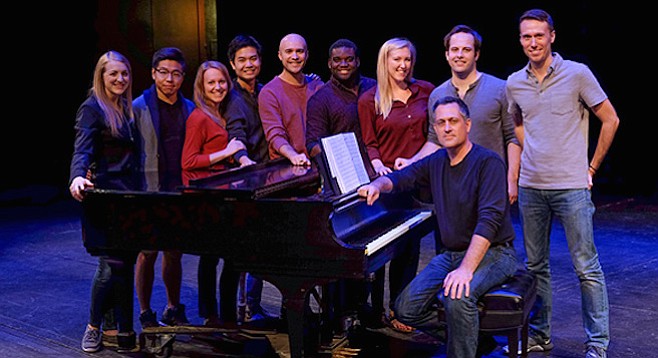 Facebook
Facebook
 X
X
 Instagram
Instagram
 TikTok
TikTok
 Youtube
Youtube

In 2014 San Diego State University’s School of Theatre, Television, and Film combined with the School of Music and Dance for an epic concert of Les Miserables. Over 200 musicians, singers, and performers roared into “At the End of the Day,” “Master of the House,” and “Do You Hear the People Sing.” They blew the doors off the walls and the walls off the building.
The schools have combined this year for a symphonic concert of Andrew Lloyd Webber and Tim Rice’s Jesus Christ Superstar with over 100 performers, but with mixed results.
It’s the last week in the life of Jesus; most — but not all — of it seen through the eyes of Judas Iscariot. The movement has “gone too far,” he says. Now Jesus’s every word “gets twisted round some other way.” Judas is rightfully paranoid, since priests of the temple and the powers of Rome “will crush us if we go too far.”
The original version had an underlying message: superstars soar and fall and may bring down their followers. But Jesus, worried no one will remember him ten minutes after he’s dead, goes beyond too far.
The original is a “rock opera.” It combines rock with musicals the way Hamilton does with rap. It has little dialogue. One song flows into the next, which naturally lends itself to a concert format.
Along with a sound system that needed a better mix (the large choir never felt full strength), the SDSU opening night favored the “opera” over the “rock.” The score calls for one star turn after another. And a hallelujah feel throughout. The singer and the band should do more than cut loose; they should own the song so freely they can add fillips and grace notes (Ted Neeley and Carl Anderson’s renditions in the movie are a high-wire act without a net).
Many singers opted for the “opera” side: whole and half notes, held for their beauty, and lagged behind the beat. Staccato slashes would better serve the turmoil embedded in the songs.
The singers who favored “rock” stood out: Katie Banville’s Caiaphas and Kimberly Moller’s Annas; Vinh Nuguyen’s Simon Zealotes (“Christ you know I love you/Did you see I waved); Colden Lamb’s flashy lounge act Herod; and especially Jonathan Brugioni’s knockout Pontius Pilate, who comes to see snakes where others see rainbows.
Tug Watson gives Jesus a clear, articulate voice. His version of the difficult soliloquy “Gethsemane” passes the Superstar Test. But with more vocal grounding — bring it up from the floor, rather than the diaphragm — he could really rock the cynics.
Domonique D. Evans bravely sang Judas’s songs with a near blown-out voice.
The large band, conducted by Robert Meffe, opened with many an unpromising clunker but eventually settled in. Charles Murdock Lucas’s set and useful projections (the days of the final week) worked well. Adam Danska’s Vegas glitz lighting, tight-coned shafts and in-your-face blasts like approaching headlights were Superstar-worthy.
Playing through December 4


In 2014 San Diego State University’s School of Theatre, Television, and Film combined with the School of Music and Dance for an epic concert of Les Miserables. Over 200 musicians, singers, and performers roared into “At the End of the Day,” “Master of the House,” and “Do You Hear the People Sing.” They blew the doors off the walls and the walls off the building.
The schools have combined this year for a symphonic concert of Andrew Lloyd Webber and Tim Rice’s Jesus Christ Superstar with over 100 performers, but with mixed results.
It’s the last week in the life of Jesus; most — but not all — of it seen through the eyes of Judas Iscariot. The movement has “gone too far,” he says. Now Jesus’s every word “gets twisted round some other way.” Judas is rightfully paranoid, since priests of the temple and the powers of Rome “will crush us if we go too far.”
The original version had an underlying message: superstars soar and fall and may bring down their followers. But Jesus, worried no one will remember him ten minutes after he’s dead, goes beyond too far.
The original is a “rock opera.” It combines rock with musicals the way Hamilton does with rap. It has little dialogue. One song flows into the next, which naturally lends itself to a concert format.
Along with a sound system that needed a better mix (the large choir never felt full strength), the SDSU opening night favored the “opera” over the “rock.” The score calls for one star turn after another. And a hallelujah feel throughout. The singer and the band should do more than cut loose; they should own the song so freely they can add fillips and grace notes (Ted Neeley and Carl Anderson’s renditions in the movie are a high-wire act without a net).
Many singers opted for the “opera” side: whole and half notes, held for their beauty, and lagged behind the beat. Staccato slashes would better serve the turmoil embedded in the songs.
The singers who favored “rock” stood out: Katie Banville’s Caiaphas and Kimberly Moller’s Annas; Vinh Nuguyen’s Simon Zealotes (“Christ you know I love you/Did you see I waved); Colden Lamb’s flashy lounge act Herod; and especially Jonathan Brugioni’s knockout Pontius Pilate, who comes to see snakes where others see rainbows.
Tug Watson gives Jesus a clear, articulate voice. His version of the difficult soliloquy “Gethsemane” passes the Superstar Test. But with more vocal grounding — bring it up from the floor, rather than the diaphragm — he could really rock the cynics.
Domonique D. Evans bravely sang Judas’s songs with a near blown-out voice.
The large band, conducted by Robert Meffe, opened with many an unpromising clunker but eventually settled in. Charles Murdock Lucas’s set and useful projections (the days of the final week) worked well. Adam Danska’s Vegas glitz lighting, tight-coned shafts and in-your-face blasts like approaching headlights were Superstar-worthy.
Playing through December 4
Comments